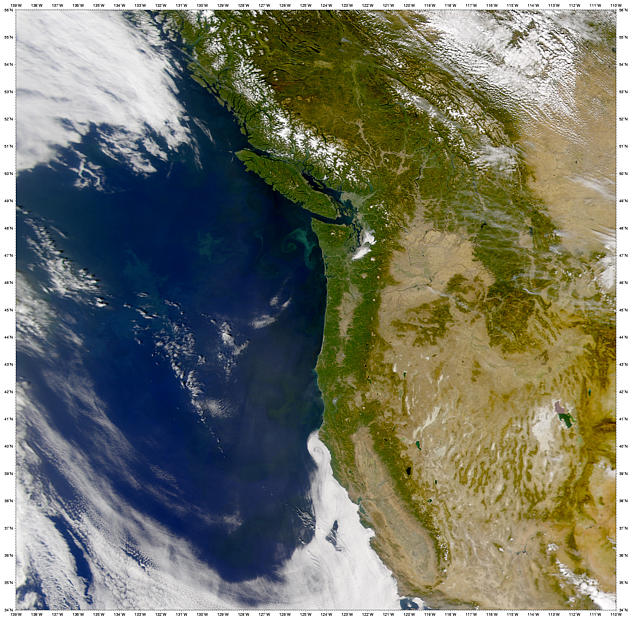In Seattle, we live right on the edge of our continent. Only the Olympic Mountains and Vancouver Island shelter us from the wind blowing in from the largest ocean on Earth. That wind arrives glistening with water vapor and confronts the Cascade Mountain range. Forced upwards by the volcanic peaks and tectonically uplifted land, the moist air cools, forming mist, rain, and snow.
As a consequence, western Washington is verdant and reknown for its fertile, productive valleys and forested slopes. In contrast, condensation denies the eastern part of the State bountiful water. Yet the land there is productive, too, for basking in the abundant sunlight runs the Columbia, the mightiest river on the West Coast of the nation.
The proximity of the Pacific has other powerful effects on the environment in Seattle. The tremendous thermal mass of the ocean and Puget Sound means that air temperatures in Seattle rarely fall below freezing. The winds and tides conspire to mix nutrients up into the bright surface layers of the ocean, fertilizing a vast ecosystem offshore, along the coast, and in the Sound. The keystone predators of that ecosystem are our most popular icons: salmon and orca whales.
As much as we like to complain about the drizzle, the flow of water from ocean to continent in our region makes our lives remarkably easy. Seattle thirsts are quenched by precipitation that falls into a few drainages in the nearby Cascade foothills. Snow and rain fills numerous reservoirs, constituting a renewable source of energy that is easily stored and provides nearly 90% of electricity demand in Seattle at extremely inexpensive rates (that do not internalize some potentially significant costs, like the extinction of salmon). Other less lucky cities either have long, unpleasant histories of scrabbling for such resource abundance, or must struggle to meet the demands of increasing populations.
So let us take advantage of our unusual position by leading the country. We are already living comfortably through abundant renewable energy (hydropower), but we need to re-think what mix of renewable technologies is most sustainable. As our population continues to increase, we must continue taking action to improve our communities and society.
Unfortunately, most evidence suggests that we have a long way to go. Here are indicator reports for the Pacific Northwest that help reveal our status and progress (or lack of it):

This satellite image of the Pacific Northwest was acquired on October 3, 2001, by the Sea-viewing Wide Field-of-view Sensor (SeaWiFS). What patterns do you discern on the land and in the ocean? What processes do you think generated the patterns that you detect? Click on the image to view our home at a much higher resolution (warning: large file size [2.9 Megabytes]!)...
Image credit: NASA Earth Observatory